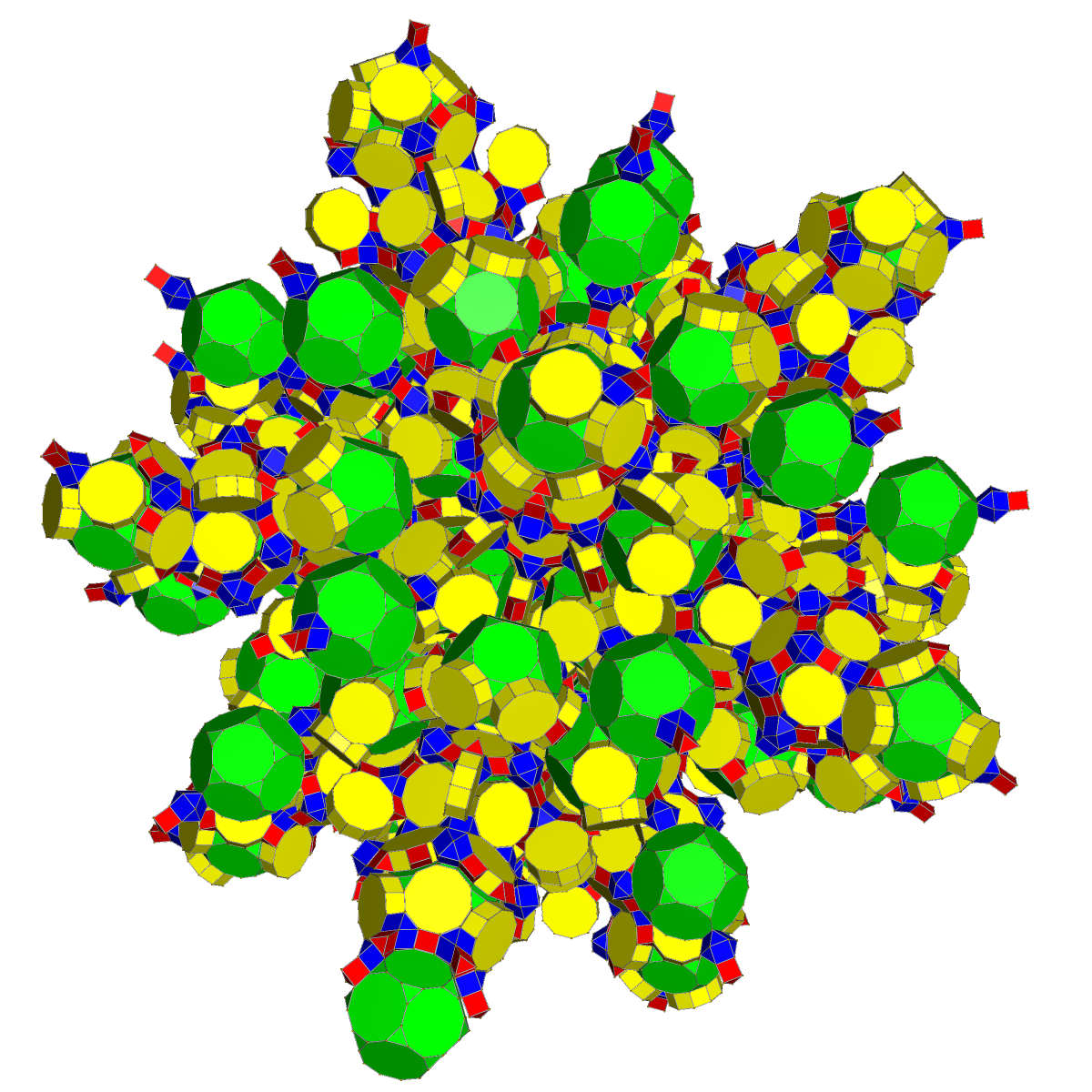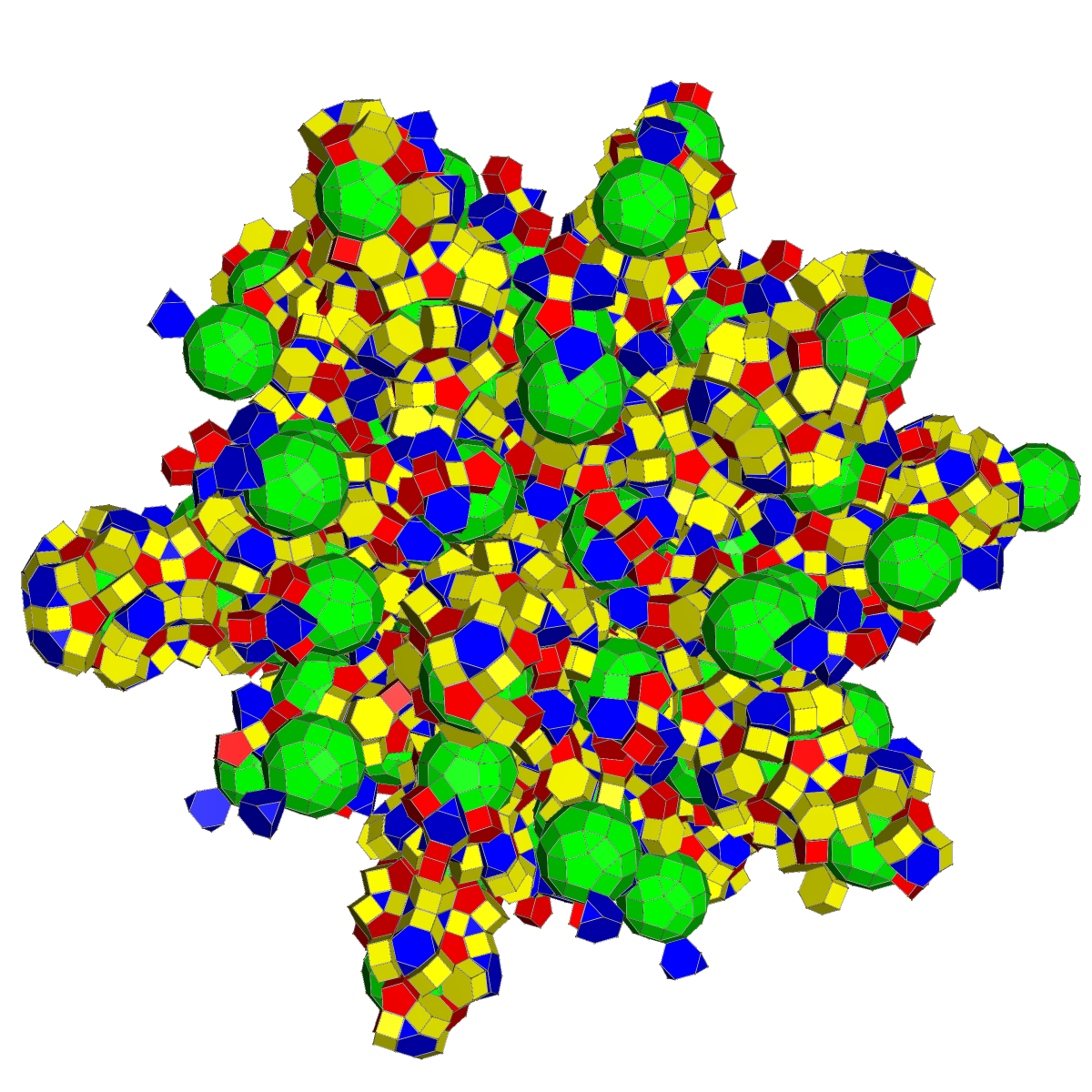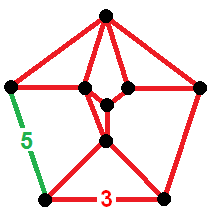Runcitruncated 600-cell on:
[Wikipedia]
[Google]
[Amazon]
In four-dimensional
 The runcinated 120-cell or small disprismatohexacosihecatonicosachoron is a
The runcinated 120-cell or small disprismatohexacosihecatonicosachoron is a
 The runcitruncated 120-cell or prismatorhombated hexacosichoron is a
The runcitruncated 120-cell or prismatorhombated hexacosichoron is a
 The runcitruncated 600-cell or prismatorhombated hecatonicosachoron is a
The runcitruncated 600-cell or prismatorhombated hecatonicosachoron is a
Bridges Conference
 The full snub 120-cell or omnisnub 120-cell, defined as an alternation of the omnitruncated 120-cell, can not be made uniform, but it can be given Coxeter diagram , and
The full snub 120-cell or omnisnub 120-cell, defined as an alternation of the omnitruncated 120-cell, can not be made uniform, but it can be given Coxeter diagram , and
Kaleidoscopes: Selected Writings of H.S.M. Coxeter
', edited by F. Arthur Sherk, Peter McMullen, Anthony C. Thompson, Asia Ivic Weiss, Wiley-Interscience Publication, 1995, ** (Paper 22) H.S.M. Coxeter, ''Regular and Semi-Regular Polytopes I'', ath. Zeit. 46 (1940) 380-407, MR 2,10** (Paper 23) H.S.M. Coxeter, ''Regular and Semi-Regular Polytopes II'', ath. Zeit. 188 (1985) 559-591** (Paper 24) H.S.M. Coxeter, ''Regular and Semi-Regular Polytopes III'', ath. Zeit. 200 (1988) 3-45*
Four-dimensional Archimedean Polytopes
(German), Marco Möller, 2004 PhD dissertation
m55
* * x3o3o5x - sidpixhi, x3o3x5x - prix, x3x3o5x - prahi, x3x3x5x - gidpixhi
t03t013t013t0123
{{DEFAULTSORT:Runcinated 120-Cell 4-polytopes
geometry
Geometry (; ) is, with arithmetic, one of the oldest branches of mathematics. It is concerned with properties of space such as the distance, shape, size, and relative position of figures. A mathematician who works in the field of geometry is c ...
, a runcinated 120-cell (or ''runcinated 600-cell'') is a convex uniform 4-polytope
In geometry, a uniform 4-polytope (or uniform polychoron) is a 4-dimensional polytope which is vertex-transitive and whose cells are uniform polyhedra, and faces are regular polygons.
There are 47 non-prismatic convex uniform 4-polytopes. There ...
, being a runcination
In geometry, runcination is an operation that cuts a regular polytope (or honeycomb) simultaneously along the faces, edges, and vertices, creating new facets in place of the original face, edge, and vertex centers.
It is a higher order truncatio ...
(a 3rd order truncation) of the regular 120-cell
In geometry, the 120-cell is the convex regular 4-polytope (four-dimensional analogue of a Platonic solid) with Schläfli symbol . It is also called a C120, dodecaplex (short for "dodecahedral complex"), hyperdodecahedron, polydodecahedron, heca ...
.
There are 4 degrees of runcinations of the 120-cell including with permutations truncations and cantellations.
The ''runcinated 120-cell'' can be seen as an expansion
Expansion may refer to:
Arts, entertainment and media
* ''L'Expansion'', a French monthly business magazine
* ''Expansion'' (album), by American jazz pianist Dave Burrell, released in 2004
* ''Expansions'' (McCoy Tyner album), 1970
* ''Expansio ...
applied to a regular 4-polytope, the 120-cell or 600-cell.
Runcinated 120-cell
 The runcinated 120-cell or small disprismatohexacosihecatonicosachoron is a
The runcinated 120-cell or small disprismatohexacosihecatonicosachoron is a uniform 4-polytope
In geometry, a uniform 4-polytope (or uniform polychoron) is a 4-dimensional polytope which is vertex-transitive and whose cells are uniform polyhedra, and faces are regular polygons.
There are 47 non-prismatic convex uniform 4-polytopes. There ...
. It has 2640 cells: 120 dodecahedra
In geometry, a dodecahedron (Greek , from ''dōdeka'' "twelve" + ''hédra'' "base", "seat" or "face") or duodecahedron is any polyhedron with twelve flat faces. The most familiar dodecahedron is the regular dodecahedron with regular pentagon ...
, 720 pentagonal prism
In geometry, the pentagonal prism is a prism with a pentagonal base. It is a type of heptahedron with seven faces, fifteen edges, and ten vertices. As a semiregular (or uniform) polyhedron
If faces are all regular, the pentagonal prism is ...
s, 1200 triangular prism
In geometry, a triangular prism is a three-sided prism; it is a polyhedron made of a triangular base, a translated copy, and 3 faces joining corresponding sides. A right triangular prism has rectangular sides, otherwise it is ''oblique''. A unif ...
s, and 600 tetrahedra
In geometry, a tetrahedron (plural: tetrahedra or tetrahedrons), also known as a triangular pyramid, is a polyhedron composed of four triangular faces, six straight edges, and four vertex corners. The tetrahedron is the simplest of all the o ...
. Its vertex figure
In geometry, a vertex figure, broadly speaking, is the figure exposed when a corner of a polyhedron or polytope is sliced off.
Definitions
Take some corner or Vertex (geometry), vertex of a polyhedron. Mark a point somewhere along each connect ...
is a nonuniform triangular antiprism
In geometry, an antiprism or is a polyhedron composed of two parallel direct copies (not mirror images) of an polygon, connected by an alternating band of triangles. They are represented by the Conway notation .
Antiprisms are a subclass o ...
(equilateral-triangular antipodium): its bases represent a dodecahedron and a tetrahedron, and its flanks represent three triangular prisms and three pentagonal prisms.
Alternate names
* Runcinated 120-cell / Runcinated 600-cell ( Norman W. Johnson) ** Runcinated hecatonicosachoron / Runcinated dodecacontachoron / Runcinated hexacosichoron / Runcinated polydodecahedron / Runcinated polytetrahedron * Small diprismatohexacosihecatonicosachoron (acronym: sidpixhi) (George Olshevsky, Jonathan Bowers)Images
Runcitruncated 120-cell
 The runcitruncated 120-cell or prismatorhombated hexacosichoron is a
The runcitruncated 120-cell or prismatorhombated hexacosichoron is a uniform 4-polytope
In geometry, a uniform 4-polytope (or uniform polychoron) is a 4-dimensional polytope which is vertex-transitive and whose cells are uniform polyhedra, and faces are regular polygons.
There are 47 non-prismatic convex uniform 4-polytopes. There ...
. It contains 2640 cells: 120 truncated dodecahedra, 720 decagonal prism
In geometry, the decagonal prism is the eighth in the infinite set of prisms, formed by ten square side faces and two regular decagon caps. With twelve faces, it is one of many nonregular dodecahedra. The decagonal prism has 12 faces, 30 edges, a ...
s, 1200 triangular prism
In geometry, a triangular prism is a three-sided prism; it is a polyhedron made of a triangular base, a translated copy, and 3 faces joining corresponding sides. A right triangular prism has rectangular sides, otherwise it is ''oblique''. A unif ...
s, and 600 cuboctahedra. Its vertex figure
In geometry, a vertex figure, broadly speaking, is the figure exposed when a corner of a polyhedron or polytope is sliced off.
Definitions
Take some corner or Vertex (geometry), vertex of a polyhedron. Mark a point somewhere along each connect ...
is an irregular rectangular pyramid, with one truncated dodecahedron, two decagonal prisms, one triangular prism, and one cuboctahedron.
Alternate names
* Runcicantellated 600-cell ( Norman W. Johnson) * Prismatorhombated hexacosichoron (Acronym: prix) (George Olshevsky, Jonathan Bowers)Images
Runcitruncated 600-cell
 The runcitruncated 600-cell or prismatorhombated hecatonicosachoron is a
The runcitruncated 600-cell or prismatorhombated hecatonicosachoron is a uniform 4-polytope
In geometry, a uniform 4-polytope (or uniform polychoron) is a 4-dimensional polytope which is vertex-transitive and whose cells are uniform polyhedra, and faces are regular polygons.
There are 47 non-prismatic convex uniform 4-polytopes. There ...
. It is composed of 2640 cells: 120 rhombicosidodecahedron
In geometry, the rhombicosidodecahedron is an Archimedean solid, one of thirteen convex isogonal nonprismatic solids constructed of two or more types of regular polygon faces.
It has 20 regular triangular faces, 30 square (geometry), square face ...
, 600 truncated tetrahedra
In geometry, the truncated tetrahedron is an Archimedean solid. It has 4 regular hexagonal faces, 4 equilateral triangle faces, 12 vertices and 18 edges (of two types). It can be constructed by truncating all 4 vertices of a regular tetrahedron ...
, 720 pentagonal prism
In geometry, the pentagonal prism is a prism with a pentagonal base. It is a type of heptahedron with seven faces, fifteen edges, and ten vertices. As a semiregular (or uniform) polyhedron
If faces are all regular, the pentagonal prism is ...
s, and 1200 hexagonal prism
In geometry, the hexagonal prism is a prism with hexagonal base. Prisms are polyhedrons; this polyhedron has 8 faces, 18 edges, and 12 vertices..
Since it has 8 faces, it is an octahedron. However, the term ''octahedron'' is primarily used ...
s. It has 7200 vertices, 18000 edges, and 13440 faces (2400 triangles, 7200 squares, and 2400 hexagons).
Alternate names
* Runcicantellated 120-cell ( Norman W. Johnson) * Prismatorhombated hecatonicosachoron (Acronym: prahi) (George Olshevsky, Jonathan Bowers)Images
Omnitruncated 120-cell
The omnitruncated 120-cell or great disprismatohexacosihecatonicosachoron is a convexuniform 4-polytope
In geometry, a uniform 4-polytope (or uniform polychoron) is a 4-dimensional polytope which is vertex-transitive and whose cells are uniform polyhedra, and faces are regular polygons.
There are 47 non-prismatic convex uniform 4-polytopes. There ...
, composed of 2640 cells: 120 truncated icosidodecahedra, 600 truncated octahedra
In geometry, the truncated octahedron is the Archimedean solid that arises from a regular octahedron by removing six pyramids, one at each of the octahedron's vertices. The truncated octahedron has 14 faces (8 regular hexagon, hexagons and 6 Squa ...
, 720 decagonal prism
In geometry, the decagonal prism is the eighth in the infinite set of prisms, formed by ten square side faces and two regular decagon caps. With twelve faces, it is one of many nonregular dodecahedra. The decagonal prism has 12 faces, 30 edges, a ...
s, and 1200 hexagonal prism
In geometry, the hexagonal prism is a prism with hexagonal base. Prisms are polyhedrons; this polyhedron has 8 faces, 18 edges, and 12 vertices..
Since it has 8 faces, it is an octahedron. However, the term ''octahedron'' is primarily used ...
s. It has 14400 vertices, 28800 edges, and 17040 faces (10800 squares, 4800 hexagons, and 1440 decagons). It is the largest nonprismatic convex uniform 4-polytope
In geometry, a uniform 4-polytope (or uniform polychoron) is a 4-dimensional polytope which is vertex-transitive and whose cells are uniform polyhedra, and faces are regular polygons.
There are 47 non-prismatic convex uniform 4-polytopes. There ...
.
The vertices and edges form the Cayley graph
In mathematics, a Cayley graph, also known as a Cayley color graph, Cayley diagram, group diagram, or color group is a graph that encodes the abstract structure of a group. Its definition is suggested by Cayley's theorem (named after Arthur Cay ...
of the Coxeter group
In mathematics, a Coxeter group, named after H. S. M. Coxeter, is an abstract group that admits a formal description in terms of reflections (or kaleidoscopic mirrors). Indeed, the finite Coxeter groups are precisely the finite Euclidean refl ...
H4.
Alternate names
* Omnitruncated 120-cell / Omnitruncated 600-cell ( Norman W. Johnson) * Omnitruncated hecatonicosachoron / Omnitruncated hexacosichoron / Omnitruncated polydodecahedron / Omnitruncated polytetrahedron * Great diprismatohexacosihecatonicosachoron (Acronym gidpixhi) (George Olshevsky, Jonathan Bowers)Images
Models
The first complete physical model of a 3D projection of the omnitruncated 120-cell was built by a team led by Daniel Duddy and David Richter on August 9, 2006 using the Zome system in the London Knowledge Lab for the 200Bridges Conference
Full snub 120-cell
 The full snub 120-cell or omnisnub 120-cell, defined as an alternation of the omnitruncated 120-cell, can not be made uniform, but it can be given Coxeter diagram , and
The full snub 120-cell or omnisnub 120-cell, defined as an alternation of the omnitruncated 120-cell, can not be made uniform, but it can be given Coxeter diagram , and symmetry
Symmetry (from grc, συμμετρία "agreement in dimensions, due proportion, arrangement") in everyday language refers to a sense of harmonious and beautiful proportion and balance. In mathematics, "symmetry" has a more precise definit ...
,3,3sup>+, and constructed from 1200 octahedron
In geometry, an octahedron (plural: octahedra, octahedrons) is a polyhedron with eight faces. The term is most commonly used to refer to the regular octahedron, a Platonic solid composed of eight equilateral triangles, four of which meet at ea ...
s, 600 icosahedron
In geometry, an icosahedron ( or ) is a polyhedron with 20 faces. The name comes and . The plural can be either "icosahedra" () or "icosahedrons".
There are infinitely many non- similar shapes of icosahedra, some of them being more symmetrica ...
s, 720 pentagonal antiprism
In geometry, the pentagonal antiprism is the third in an infinite set of antiprisms formed by an even-numbered sequence of triangle sides closed by two polygon caps. It consists of two pentagons joined to each other by a ring of 10 triangles for ...
s, 120 snub dodecahedron
In geometry, the snub dodecahedron, or snub icosidodecahedron, is an Archimedean solid, one of thirteen convex isogonal nonprismatic solids constructed by two or more types of regular polygon faces.
The snub dodecahedron has 92 faces (the most ...
s, and 7200 tetrahedron
In geometry, a tetrahedron (plural: tetrahedra or tetrahedrons), also known as a triangular pyramid, is a polyhedron composed of four triangular faces, six straight edges, and four vertex corners. The tetrahedron is the simplest of all the o ...
s filling the gaps at the deleted vertices. It has 9840 cells, 35040 faces, 32400 edges, and 7200 vertices.
Related polytopes
These polytopes are a part of a set of 15uniform 4-polytope
In geometry, a uniform 4-polytope (or uniform polychoron) is a 4-dimensional polytope which is vertex-transitive and whose cells are uniform polyhedra, and faces are regular polygons.
There are 47 non-prismatic convex uniform 4-polytopes. There ...
s with H4 symmetry:
Notes
References
*Kaleidoscopes: Selected Writings of H.S.M. Coxeter
', edited by F. Arthur Sherk, Peter McMullen, Anthony C. Thompson, Asia Ivic Weiss, Wiley-Interscience Publication, 1995, ** (Paper 22) H.S.M. Coxeter, ''Regular and Semi-Regular Polytopes I'', ath. Zeit. 46 (1940) 380-407, MR 2,10** (Paper 23) H.S.M. Coxeter, ''Regular and Semi-Regular Polytopes II'', ath. Zeit. 188 (1985) 559-591** (Paper 24) H.S.M. Coxeter, ''Regular and Semi-Regular Polytopes III'', ath. Zeit. 200 (1988) 3-45*
J.H. Conway
John Horton Conway (26 December 1937 – 11 April 2020) was an English people, English mathematician active in the theory of finite groups, knot theory, number theory, combinatorial game theory and coding theory. He also made contributions to ...
and M.J.T. Guy: ''Four-Dimensional Archimedean Polytopes'', Proceedings of the Colloquium on Convexity at Copenhagen, page 38 und 39, 1965
* N.W. Johnson: ''The Theory of Uniform Polytopes and Honeycombs'', Ph.D. Dissertation, University of Toronto, 1966Four-dimensional Archimedean Polytopes
(German), Marco Möller, 2004 PhD dissertation
* * x3o3o5x - sidpixhi, x3o3x5x - prix, x3x3o5x - prahi, x3x3x5x - gidpixhi
External links
* H4 uniform polytopes with coordinatest03
{{DEFAULTSORT:Runcinated 120-Cell 4-polytopes